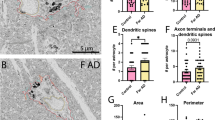Summary
Morphometric glial fibrillary acidic protein (GFAP) studies of the brains of 11 old (18–29 months) female, outbred athymic mice demonstrated astrocytic gliosis (increase in GFAP-positive astrocytes; GFAP-PA) in all mice with a consistent distribution pattern. Specific areas such as the central white matter, hippocampus, diencephalon, gray matter at the floor of the 4th ventricle, and posterior colliculi showed the change most conspicuously, revealing GFAP-PA both interstitially and perivascularly. There was no apparent demyelination in the affected white matter. In addition, there was an increase in GFAP-PA in the external limiting membrane surrounding the diencephalon and base of brain stem, but only to a minor degree over the cerebral hemispheres. The cerebral and cerebellar cortices and hypothalamus showed no significant increase. In contrast, all of the 2-month-old control animals showed only minor amounts of GFAP-PA, seen in the external limiting membrane and a trace in the cerebral white matter. The present data suggest that astroglial sclerotic change in various regions of the brain is an important morphological expression of cerebral aging. In view of the lack of other demonstrable histological changes (i.e., silver and amyloid stains were negative) or significant atrophy, the cause of the observed gliosis in BALB/c mice might represent a genuine aging change. As an incidental finding, aggregates of PAS-positive granules were noted in the Ammon's horn of most old animals, while none were seen in the young controls.
Similar content being viewed by others
References
Adams I, Jones DG (1983) Synaptic remodelling and astrocytic hypertrophy in rat cerebral cortex from early to late adulthood. Neurobiol Aging 3:179–186
de la Roza C, Cano J, Reinoso-Suarez F (1985) An electron microscopic study of astroglia and oligodendroglia in the lateral geniculate nucleus of aged rats. Mech Ageing Dev 29:267–281
Duffy PE, Rapport M, Graf L (1980) Glial fibrillary acidic protein and Alzheimer-type senile dementia. Neurology 30:778–782
Geinisman Y, Bondareff W, Dodge JT (1978) Hypertrophy of astroglial processes in the dentate gyrus of the senescent rat. Am J Anat 153:537–544
Hara M (1986) Microscopic globular bodies in the human brain. J Neuropathol Exp Neurol 45:169–178
Hsu SM, Raine L, Fanger H (1981) The use of avidin-biotinperoxidase complex (ABC) in immunoperoxidase techniques: a comparison between ABC and unlabeled antibody (PAP) procedures. J Histochem Cytochem 29:577–580
Lamar CH, Hinsman EJ, Henrickson CK (1976) Alterations in the hippocampus of aged mice. Acta Neuropathol (Berl) 36:387–391
Landfield PW, Rose G, Sandles L, Wohlstadter TC, Lynch G (1977) Patterns of astroglial hypertrophy and neuronal degeneration in the hippocampus of aged, memory-deficient rats. J Gerontol 32:3–12
Lindsey JD, Landfield PW, Lynch G (1979) Early onset and topographical distribution of hypertrophied astrocytes in hippocampus of aging rats: a quantitative study. J Gerontol 34:661–671
Mancardi GL, Liwnicz BH, Mandybur TI (1983) Fibrous astrocytes in Alzheimer's disease and senile dementia of Alzheimer's type. Acta Neuropathol (Berl) 61:76–80
Mervis R (1978) Golgi Study. Exp Neurol 62:417–432
O'Kusky J, Colonnier M (1982) Postnatal changes in the number of astrocytes, oligodendrocytes, and microglia in the visual cortex (area 17) of the macaque monkey: a stereological analysis in normal and monocularly deprived animals. J Comp Neurol 210:307–315
Pauli B, Luginbuhl H (1971) Fluoreszenzmicroskopische Untersuchungen der cerebralen Amyloidose bei alten Hunden und senilen Menschen. Acta Neuropathol (Berl) 19:121–128
Probst A, Ulrich J, Heitz PhU (1982) Senile dementia of Alzheimer type: astroglial reaction to extracellular neurofibrillary tangles in the hippocampus. Acta Neuropathol (Berl) 57:75–79
Schechter R, Yen S-HC, Terry RD (1980) Fibrous astrocytes in senile dementia of the Alzheimer type. J Neuropathol Exp Neurol 40:95–101
Struble RG, Kitt CA, Walker LC, Cork LC, Price DL (1984) Somatostatinergic neurites in senile plaques of aged nonhuman primates. Brain Res 324:394–396
Suzuki Y, Atoji Y, Suu S (1978) Microtubules observed within cistern of RER in neurons of aged dogs. Acta Neuropathol (Berl) 44:155–158
Wisniewski H, Johnson AB, Raine CS, Kay WY, Terry RD (1970) Senile plaques and cerebral amyloidosis in aged dogs. Lab Invest 23:287–296
Wisniewski H, Ghetti B, Terry RD (1973) Neuritic (senile) plaques and filamentous changes in aged rhesus monkeys. J Neuropathol Exp Neurol 32:566–584
Author information
Authors and Affiliations
Rights and permissions
About this article
Cite this article
Mandybur, T.I., Ormsby, I. & Zemlan, F.P. Cerebral aging: a quantitative study of gliosis in old nude mice. Acta Neuropathol 77, 507–513 (1989). https://doi.org/10.1007/BF00687252
Received:
Revised:
Accepted:
Issue Date:
DOI: https://doi.org/10.1007/BF00687252




